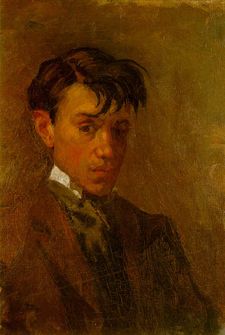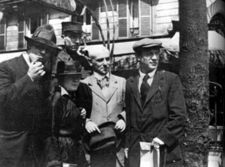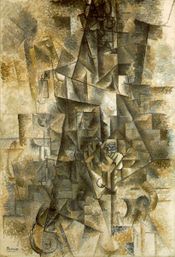Pablo Picasso
2007 Schools Wikipedia Selection. Related subjects: Artists
Pablo Picasso ( October 25, 1881 – April 8, 1973) was a Spanish painter and sculptor. One of the most recognized figures in 20th century art, he is best known as the co-founder, along with Georges Braque, of cubism. It has been estimated that Picasso produced about 13,500 paintings or designs, 100,000 prints or engravings, 34,000 book illustrations and 300 sculptures or ceramics.
Career
Early life
Pablo Picasso was born in Málaga, Spain, the first child of José Ruiz y Blasco and María Picasso y López.
Picasso's father was Jose Ruíz, a painter whose specialty was the naturalistic depiction of birds, and who for most of his life was also a professor of art at the School of Crafts and a curator of a local museum. The young Picasso showed a passion and a skill for drawing from an early age; according to his mother, his first word was "piz," a shortening of lapiz, the Spanish word for pencil. It was from his father that Picasso had his first formal academic art training, such as figure drawing and painting in oil. Although Picasso attended carpenter schools throughout his childhood, often those where his father taught, he never finished his college-level course of study at the Academy of Arts (Academia de San Fernando) in Madrid, leaving after less than a year.
Personal life
In the early years of the twentieth century, Picasso, still a struggling youth, began a long term relationship with Fernande Olivier. It is she who appears in many of the Rose period paintings. After garnering fame and some fortune, Picasso left Olivier for Marcelle Humbert, whom Picasso called Eva. Picasso included declarations of his love for Eva in many Cubist works.
In Paris, Picasso entertained a distinguished coterie of friends in the Montmartre and Montparnasse quarters, including André Breton, Guillaume Apollinaire, and writer Gertrude Stein. He maintained a number of mistresses in addition to his wife or primary partner. Picasso was married twice and had four children by three women.
In 1918, Picasso married Olga Khokhlova, a ballerina with Sergei Diaghilev's troupe, for whom Picasso was designing a ballet, Parade, in Rome. Khokhlova introduced Picasso to high society, formal dinner parties, and all the social niceties attendant on the life of the rich in 1920s Paris. The two had a son, Paulo, who would grow up to be a dissolute motorcycle racer and chauffeur to his father.
Khokhlova's insistence on social propriety clashed with Picasso's bohemian tendencies and the two lived in a state of constant conflict. In 1927 Picasso met 17 year old Marie-Thérèse Walter and began a secret affair with her. Picasso's marriage to Khokhlova soon ended in separation rather than divorce, as French law required an even division of property in the case of divorce, and Picasso did not want Khokhlova to have half his wealth. The two remained legally married until Khokhlova's death in 1955.
Picasso carried on a long-standing affair with Walter and fathered a daughter, Maia, with her. Marie-Thérèse lived in the vain hope that Picasso would one day marry her, and hanged herself four years after Picasso's death.
The photographer and painter Dora Maar was also a constant companion and lover of Picasso. The two were closest in the late 1930s and early 1940s and it was Maar who documented the painting of Guernica.
After the liberation of Paris in 1944, Picasso began to keep company with a young art student, Françoise Gilot. The two eventually became lovers, and had two children together, Claude, and Paloma. Unique among Picasso's women, Gilot left Picasso in 1953, allegedly because of abusive treatment and infidelities. This came as a severe blow to Picasso.
He went through a difficult period after Gilot's departure, coming to terms with his advancing age and his perception that, now in his 70s, he was no longer attractive, but rather grotesque to young women. A number of ink drawings from this period explore this theme of the hideous old dwarf as buffoonish counterpoint to the beautiful young girl, including several from a six-week affair with Geneviève Laporte, who in June 2005 auctioned off the drawings Picasso made of her.
Picasso was not long in finding another lover, Jacqueline Roque. Roque worked at the Madoura Pottery, where Picasso made and painted ceramics. The two remained together for the rest of Picasso's life, marrying in 1961. Their marriage was also the means of one last act of revenge against Gilot. Gilot had been seeking a legal means to legitimize her children with Picasso, Claude and Paloma. With Picasso's encouragement, she had arranged to divorce her then husband, Luc Simon, and marry Picasso to secure her children's rights. Picasso then secretly married Roque after Gilot had filed for divorce in order to exact his revenge for her leaving him.
Picasso had constructed a huge gothic structure and could afford large villas in the south of France, at Notre-dame-de-vie on the outskirts of Mougins, in the Provence-Alpes-Côte d'Azur. Although he was a celebrity, there was often as much interest in his personal life as his art.
In addition to his manifold artistic accomplishments, Picasso had a film career, including a cameo appearance in Jean Cocteau's Testament of Orpheus. Picasso always played himself in his film appearances. In 1955 he helped make the film Le Mystère Picasso (The Mystery of Picasso) directed by Henri-Georges Clouzot.
Pablo Picasso died on April 8, 1973 in Mougins, France, while Picasso and his wife Jacqueline entertained friends for dinner. His final words were "Drink to me, drink to my health, you know I can't drink any more." He was interred at Castle Vauvenargues' park, in Vauvenargues, Bouches-du-Rhône. Jacqueline Roque prevented his children Claude and Paloma from attending the funeral.
Pacifism
Picasso remained neutral during the Spanish Civil War, World War I and World War II, refusing to fight for any side or country. Picasso never commented on this but encouraged the idea that it was because he was a pacifist. Some of his contemporaries (including Braque) felt that this neutrality had more to do with cowardice than principle. As a Spanish citizen living in France, Picasso was under no compulsion to fight against the invading Germans in either world war. In the Spanish Civil War, service for Spaniards living abroad was optional and would have involved a voluntary return to the country to join either side. While Picasso expressed anger and condemnation of Franco and the Fascists through his art he did not take up arms against them.
He also remained aloof from the Catalan independence movement during his youth despite expressing general support and being friendly with activists within it. No political movement seemed to compel his support to any great degree, though he did become a member of the Communist Party.
During the Second World War, Picasso remained in Paris when the Germans occupied the city. The Nazis hated his style of painting, so he was not able to show his works during this time. Retreating to his studio, he continued to paint all the while. Although the Germans outlawed bronze casting in Paris, Picasso continued regardless, using bronze smuggled to him by the French resistance.
Arguably Picasso's most famous work is his depiction of the German bombing of Gernika, Spain — Guernica. This large canvas embodies for many the inhumanity, brutality and hopelessness of war.
After the Second World War, Picasso rejoined the French Communist Party, and even attended an international peace conference in Poland. But party criticism of a portrait of Stalin as insufficiently realistic cooled Picasso's interest in Communist politics, though he remained a loyal member of the Communist Party until his death. His beliefs tended towards anarcho-communism.
Picasso's work
Picasso's work is often categorized into "periods". While the names of many of his later periods are debated, the most commonly accepted periods in his work are the Blue Period (1901–1904), the Rose Period (1905–1907), the African-influenced Period (1908–1909), Analytic Cubism (1909–1912), and Synthetic Cubism (1912–1919).
Before 1901
Picasso's training under his father began before 1890. His progress can be traced in the collection of early works now held by the Museu Picasso in Barcelona, which provides one of the most comprehensive records extant of any major artist's beginnings. During 1893 the juvenile quality of his earliest work falls away; by 1894 his career as a painter can be said to begin. The academic realism apparent in the works of the mid-1890s is well displayed in The First Communion (1896), a large composition that depicts his sister, Lola. In the same year, at the age of 14, he painted Portrait of Aunt Pepa, a vigorous and dramatic portrait that has been called "without a doubt one of the greatest in the whole history of Spanish painting."
In 1897 his realism became tinged with Symbolist influence, in a series of landscape paintings rendered in nonnaturalistic violet and green tones. What some call his Modernist period (1899-1900) followed. His exposure to the work of Rossetti, Steinlen, Toulouse-Lautrec and Edvard Munch, combined with his admiration for favorite old masters such as El Greco, led Picasso to a personal version of modernism in his works of this period.
Blue Period
Picasso's Blue Period (1901–1904) consists of somber paintings rendered in shades of blue and blue-green, only occasionally warmed by other colors. This period's starting point is uncertain; it may have begun in Spain in the spring of 1901, or in Paris in the second half of the year. In his austere use of colour and sometimes doleful subject matter— prostitutes and beggars are frequent subjects—Picasso was influenced by a trip through Spain and by the suicide of his friend Carlos Casagemas. Starting in autumn of 1901 he painted several posthumous portraits of Casagemas, culminating in the gloomy allegorical painting La Vie, painted in 1903 and now in the Cleveland Museum of Art.
The same mood pervades the well-known etching The Frugal Repast (1904), which depicts a blind man and a sighted woman, both emaciated, seated at a nearly bare table. Blindness is a recurrent theme in Picasso's works of this period, also represented in The Blindman's Meal (1903, the Metropolitan Museum of Art) and in the portrait of Celestina (1903). Other frequent subjects are artists, acrobats and harlequins. The harlequin, a comedic character usually depicted in checkered patterned clothing, became a personal symbol for Picasso.
Rose Period
The Rose Period (1905–1907) is characterized by a more cheery style with orange and pink colors, and again featuring many harlequins. Picasso met Fernande Olivier, a model for sculptors and artists, in Paris in 1904, and many of these paintings are influenced by his warm relationship with her, in addition to his increased exposure to French painting.
African-influenced Period
Picasso's African-influenced Period (1907–1909) begins with the two figures on the right in his painting, Les Demoiselles d'Avignon, which were inspired by African artifacts. Formal ideas developed during this period lead directly into the Cubist period that follows.
Analytic Cubism
Analytic Cubism (1909–1912) is a style of painting Picasso developed along with Braque using monochrome brownish colours. Both artists took apart objects and "analyzed" them in terms of their shapes. Picasso and Braque's paintings at this time are very similar to each other.
Synthetic Cubism
Synthetic Cubism (1912–1919) is a further development of Cubism in which cut paper fragments—often wallpaper or portions of newspaper pages—are pasted into compositions, marking the first use of collage in fine art.
Classicism and Surrealism
In the period following the upheaval of World War I Picasso produced work in a neoclassical style. This "return to order" is evident in the work of many European artists in the 1920s, including Derain, Giorgio de Chirico, and the artists of the New Objectivity movement. Picasso's paintings and drawings from this period frequently recall the work of Ingres.
During the 1930s, the minotaur replaced the harlequin as a motif which he used often in his work. His use of the minotaur came partly from his contact with the surrealists, who often used it as their symbol, and appears in Picasso's Guernica.
Arguably Picasso's most famous work is his depiction of the German bombing of Gernika, Spain — Guernica. This large canvas embodies for many the inhumanity, brutality and hopelessness of war. Guernica hung in New York's Museum of Modern Art for many years. In 1981 Guernica was returned to Spain and exhibited at the Casón del Buen Retiro. In 1992 the painting hung in Madrid's Reina Sofía Museum when it opened.
Later works
Picasso was one of 250 sculptors who exhibited in the 3rd Sculpture International held at the Philadelphia Museum of Art in the summer of 1949. In the 1950s Picasso's style changed once again, as he took to producing reinterpretations of the art of the great masters. He made a series of works based on Velazquez's painting of Las Meninas. He also based paintings on works of art by Goya, Poussin, Manet, Courbet and Delacroix.
He was commissioned to make a maquette for a huge 50 foot high public sculpture to be built in Chicago, known usually as the Chicago Picasso. He approached the project with a great deal of enthusiasm, designing a sculpture which was ambiguous and somewhat controversial. What the figure represents is not known; it could be a bird, a horse, a woman or a totally abstract shape. The sculpture, one of the most recognizable landmarks in downtown Chicago, was unveiled in 1967. Picasso refused to be paid $100,000 for it, donating it to the people of the city.
Picasso's final works were a mixture of styles, his means of expression in constant flux until the end of his life. Devoting his full energies to his work, Picasso became more daring, his works more colourful and expressive, and from 1968 through 1971 he produced a torrent of paintings and hundreds of copperplate etchings. At the time these works were dismissed by most as pornographic fantasies of an impotent old man or the slapdash works of an artist who was past his prime. One long time admirer, Douglas Cooper, called them "the incoherent scribblings of a frenetic old man". Only later, after Picasso's death, when the rest of the art world had moved on from abstract expressionism, did the critical community come to see that Picasso had already discovered neo-expressionism and was, as so often before, ahead of his time.
Legacy
At the time of his death many of his paintings were in his possession, as he had kept off the art market what he didn't need to sell. In addition, Picasso had a considerable collection of the work of other famous artists, some his contemporaries, such as Henri Matisse, with whom he had exchanged works. Since Picasso left no will, his death duties (estate tax) to the French state were paid in the form of his works and others from his collection. These works form the core of the immense and representative collection of the Musée Picasso in Paris. In 2003, relatives of Picasso inaugurated a museum dedicated to him in his birthplace, Málaga, Spain, the Museo Picasso Málaga.
The Museu Picasso in Barcelona features many of Picasso's early works, created while he was living in Spain, including many rarely seen works which reveal Picasso's firm grounding in classical techniques. The museum also holds many precise and detailed figure studies done in his youth under his father's tutelage, as well as the extensive collection of Jaime Sabartés, Picasso's close friend from his Barcelona days who, for many years, was Picasso's personal secretary.
In the aftermath of Picasso's death, at the suggestion of Dustin Hoffman, Paul McCartney wrote a song entitled "Picasso's Last Words (Drink To Me)" in tribute to him which was released on his album Band on the Run later that year.
The film Surviving Picasso was made about Picasso in 1996, as seen through the eyes of Françoise Gilot. Anthony Hopkins played Picasso in the movie.
Some paintings by Picasso rank among the most expensive paintings in the world.
- " Nude on a Black Armchair" - sold for USD $45.1 million in 1999 to Les Wexner, who then donated it to the Wexner Centre for the Arts.
- Les Noces de Pierrette - sold for more than USD $51 million in 1999.
- Garçon à la pipe- sold for USD $104 million at Sotheby's on May 4, 2004, establishing a new price record.
- Dora Maar au Chat - sold for USD $95.2 million at Sotheby's on May 3, 2006.
Awards
- International Lenin Peace Prize (1962)
Anecdotes and trivia
A man once criticized Picasso for creating unrealistic art. Picasso asked him: "Can you show me some realistic art?" The man showed him a photograph of his wife. Picasso observed: "So your wife is two inches tall, two-dimensional, with no arms and no legs, and no colour but only shades of gray?"
The Guinness Book of Records names Picasso as the most prolific painter ever.
Picasso suffered from dyslexia.
Children
- Paulo (February 4, 1921 - June 5, 1975) - with Olga Khokhlova
- Maya (September 5, 1935 - ) - with Marie-Thérèse Walter
- Claude - with Françoise Gilot
- Paloma (1949 - ) - with Françoise Gilot
Lists of works
- List of Picasso artworks 1889-1900
- List of Picasso artworks 1901-1910
- List of Picasso artworks 1911-1920
- List of Picasso artworks 1921-1930
- List of Picasso artworks 1931-1940
- List of Picasso artworks 1941-1950
- List of Picasso artworks 1951-1960
- List of Picasso artworks 1961-1970
- List of Picasso artworks 1971-1973




